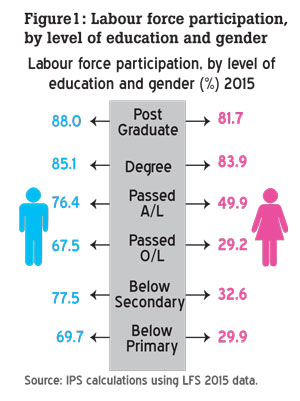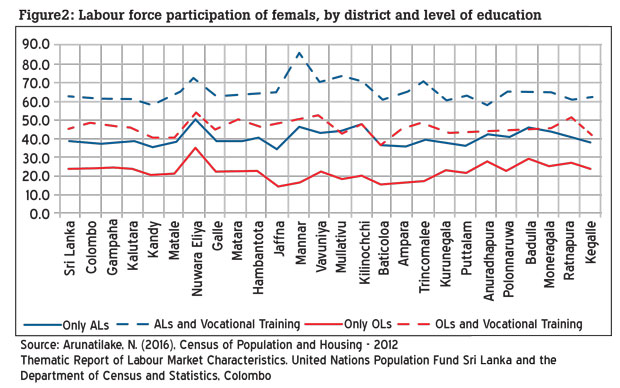31 Jul 2017 - {{hitsCtrl.values.hits}}

 There has been renewed interest among policymakers to get more women to enter the workforce. Most solutions for encouraging women to enter the labour market look at helping women balance home and market activities through initiatives such as expanding access to day care facilities and providing more flexible work opportunities.
There has been renewed interest among policymakers to get more women to enter the workforce. Most solutions for encouraging women to enter the labour market look at helping women balance home and market activities through initiatives such as expanding access to day care facilities and providing more flexible work opportunities.
The labour force participation of women differs considerably across education levels (see Figure 1). The labour force participation of highly-skilled women is on par with that of males, while the labour force participation of lower-skilled women lag behind. As such, along with the above-mentioned measures, policies for improving access to education beyond lower secondary level and the creation of better jobs are also important to encourage women to participate in the labour market.

The female labour force participation (FLFP) rate in Sri Lanka is low and has not changed much over time. According to the Census and Statistics Department’s 2015 Labour Force Survey data, the working-age population, only 35.9 percent of females were engaged in the labour market, compared to nearly 75 percent of males. These percentages have remained more or less unchanged over the years. However, as seen in Figure 1, the proportion of females engaged in the labour market steadily increases at higher levels of education.
Further, the disparity between the male and female labour force participation rates decreases steadily for those with higher levels of education. The gap between male-female participation in the labour force lowers at educational levels beyond lower secondary. This gap is lowest for those with an education level higher than a degree.
These findings are substantiated in Figure 2, which shows that the female labour force participation increases with education and this increase is seen at all levels of education and for all districts in the country. For example, as seen in Figure 2, those with A-Levels are more likely to enter the workforce than those with O-Levels.
Further, those with O-Levels and vocational training are more likely to enter the workforce than those with just O-Levels. Similarly those with A-Levels and vocational training are more likely to enter the labour force than those with just A-Levels. These results clearly show that the more educated women are, the more likely they are to enter the labour market.
Education influences female labour force participation in
several ways.
Women with higher levels of education delay marriage and childbearing. Lower fertility enables females to increase their participation in the labour market. Also, education increases the earning potential of females, making it more worthwhile to work than stay
at home.

Further, with education females can expect to earn better wages, which allows women to obtain child care and domestic help in the market, thereby giving them more space to enter the workforce.
The proportion of the 15 and above population with more than a lower secondary level education is very low in Sri Lanka. According to the Census of Population and Housing 2012 data, of the 15 and above population, only 3.3 percent (this statistic is the same for both males and females) had a degree and only slightly more than 15 percent-16 percent of females and 14 percent of males -had passed A-Levels.
The above findings suggest that policies for improving the education level of females up to A-Levels and beyond will encourage females to enter the labour market more. As shown in a recent IPS blog, only a little more than half of those sitting for O-Levels qualify to do A-Levels. This implies the importance of improving education, starting from the school level, to increase the share of skilled females in the population.
However, education alone will not get more females into the workforce. Along with education, the market has to create jobs that are desirable to more educated workers. The Sri Lankan labour market is skewed towards lower-skilled work categories. The share of workers in occupations requiring higher-level skills is lower, while most of the workers are concentrated at the lower end of the skill spectrum. The lack of opportunities in the types of occupations preferred by females with higher skills could also be a deterrent for females to enter the labour market.
Lastly, lessons learned from other countries show that to successfully encourage women to participate in the labour force, holistic policies must be implemented. Measures to facilitate work-life balance and job flexibility must go hand in hand with measures to improve skills of females and the creation of better jobs.
(This is based on a chapter written for the forthcoming Sri-Lanka: State of the Economy 2017 report, IPS’ annual flagship publication)
(Nisha Arunatilake is a Research Fellow at the Institute of Policy Studies of Sri Lanka (IPS). To view this article online and to share your comments, visit the IPS Blog ‘Talking Economics’ - http://www.ips.lk/talkingeconomics/)
06 Jan 2025 52 minute ago
06 Jan 2025 2 hours ago
06 Jan 2025 2 hours ago
06 Jan 2025 2 hours ago
06 Jan 2025 2 hours ago